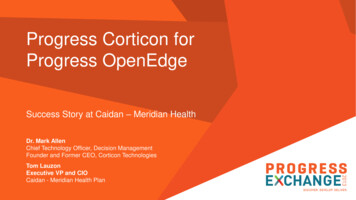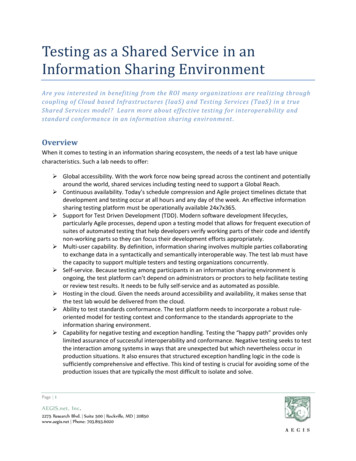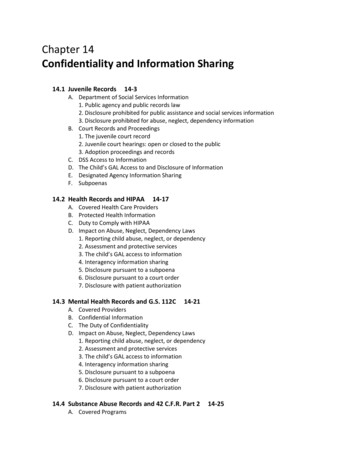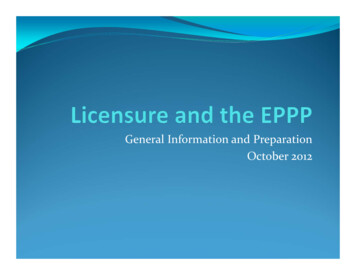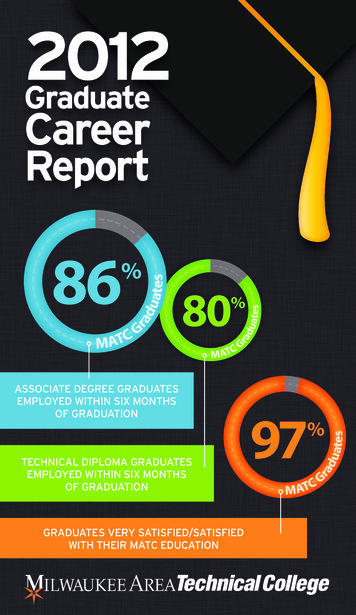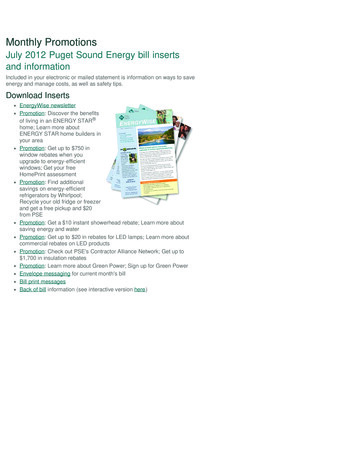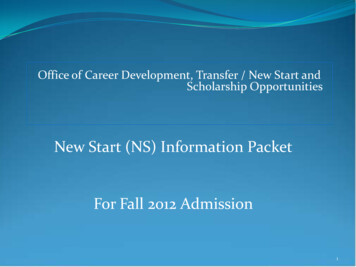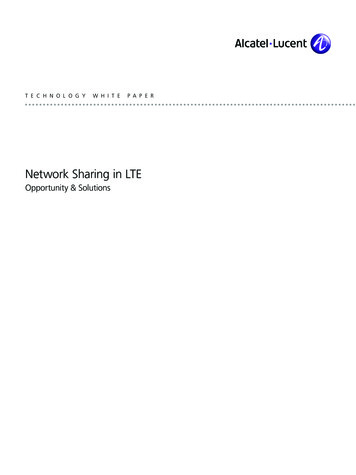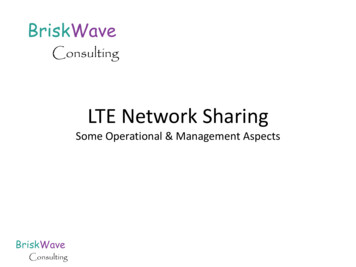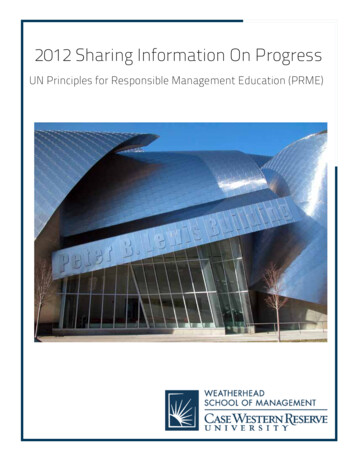
Transcription
2012 Sharing Information On ProgressUN Principles for Responsible Management Education (PRME)
Our Letter of CommitmentWe are excited that in October 2012 we will welcome Robert E. WidingII, dean of the Macquarie School of Management in Sydney, Australia, asthe new dean of the Weatherhead School of Management. Dr. Widing willensure that our commitment to PRME principles will remain at the core ofour mission; meanwhile, in the absence of a dean of Weatherhead, I wouldlike to offer my thoughts on our activities over the past two years.Our MBA program, possibly our most visible degree program, isimbued with two themes, Sustainable Enterprise—the notion thatcreating prosperity goes hand in hand with fostering a healthy naturalenvironment and human society--and Manage by Designing, theintegration of design attitude and skills into business practices. At firstglance, one might assume that the skills and techniques associated withdesign have nothing to do with socially responsible business practices. But what we have found is thatby taking into account a whole system and all stakeholders, as design teaches us to do, our studentsare frequently inspired to design processes, services, and products that have a positive impact. Perhapsdesign techniques liberate our students to pursue the social and environmental goods that they are mostinterested in.Weatherhead students at all levels are invited to explore sustainability as a driver for value creationin core curriculum for our MBA program, including the Institute for Sustainable Value and SocialEntrepreneurship, which was named among the 10 most innovative business school courses by Forbes in2010. In addition, the first candidates in our transdisciplinary Designing Sustainable Systems Track for aPhD in Management have just graduated with their doctorates. Our students also continue to take theirlearning to the next level by becoming involved with internships, organizations like Net Impact, and casecompetitions including that of the Aspen Institute.Meanwhile, our faculty have diverse interests in the spheres of social and environmental responsibility.All seven of our departments, from accountancy to organizational behavior, can point to research andteaching in these important areas. Not content to leave their research in the “ivory tower,” many of ourfaculty speak with the media on a regular basis.Our school also reaches out to our local business community and beyond through the efforts of the FowlerCenter for Sustainable Value (formerly the Center for Business as an Agent of World Benefit and renamedin 2009), which hosts guest speakers and Sustainability Circles and connects with leaders to discuss theirsustainability concerns. Weatherhead’s Executive Education department also provides programmingaround socially responsible business practices that is very popular with our client organizations.This progress report will highlight these and other results of our commitment to the PRME during 20102012.Sincerely,Roger Saillant, PhDExecutive DirectorFowler Center for Sustainable Value3
Principle 1 PurposeWe will develop the capabilities of students to be future generators ofsustainable value for business and society at large and to work for aninclusive and sustainable global economy.Weatherhead prepares students to be business leaders who understand how their valuesand decisions affect their communities and the world. We ask our students, “What is theworld you want to design?” Finding business opportunities in today’s most pressing social andenvironmental issues, and recognizing that today’s business challenges won’t be solved withyesterday’s management attitudes and solutions is at the heart of our teaching philosophy.Our interdisciplinary initiatives feed all that we do: Manage by Designing and SustainableEnterprise infuse our coursework with creative energy and innovative strategies. Students applywhat they learn and create positive impact in the world. Fellowships and internships, in-the-fieldexperiences, case competitions, clubs, and outreach programs teach students how their valuescreate value.The power of sustainabilityAs COO of MIDATCO Power Company in Nigeria,Funso Lafe, MBA ‘10, is helping to build an energyindependent village, TechVille, utilizing solar panels,wind turbines, and biofuels as power sources.MIDATCO not only installs these technologies butalso trains workers to design, install, and maintainsolar, wind, and waste-burning generators. Thesewill provide a more reliable grid for this populousand developing nation. “There are days when youget all your electricity at once, and other days whenit goes on and off. There are days when we havelight for an hour, and times when you go throughtwo days with no power,” he explains. “You have tobe very conscientious about charging your phoneand computer to last through power outages.”Lafe hopes that his company will be instrumentalin changing all of that. At Weatherhead, Lafedeveloped his abilities to see the big picture evenwhen dealing with critical minutiae of procurementand project management. His involvement is notonly in TechVille, but also in a new initiative calledPAWA 774, an acronym for Providing AlternativeWatts for all 774 local government areas in Nigeria.4
Internships and fellowshipsInternships at the Fowler Center for Sustainable ValueWeatherhead’s Fowler Center employs two students annually, providing opportunities for coauthoring and publishing sustainable value teaching cases and editorial roles for the Journal ofCorporate Citizenship. The interns also supported the Center in its former role as Secretariat tothe UN Global Compact U.S. Network. Currently, MBAs are assisting in the implementation ofSustainability Circles with businesses and non-profit organizations in Northeast Ohio.Internships at Case Western Reserve University’s Office of SustainabilitySince 2006 Weatherhead MBAs have served in CWRU’s Office of Sustainability. Students are givenleadership roles on major projects such as university-wide greenhouse gas emissions inventoriesand data collection, and analysis for annual reports.Fellowships at the Institute for Sustainable DevelopmentFor the past two years, Weatherhead MBAs are eligible for fellowships with the Institute forSustainable Development in North Carolina.Internships at the Cleveland Clinic, Office for a Healthy EnvironmentSince 2008, Weatherhead MBAs have served in Cleveland Clinic’s Office for a Healthy Environment,helping to manage sustainability programming for the 40,000-person organization.Volunteering for “Sustainable Cleveland 2019”Weatherhead facilitates the 10-year “Sustainable Cleveland 2019” project. The initiative waslaunched by the City of Cleveland and involves thousands of stakeholders throughout NortheastOhio. Each year, stakeholders come together for an Appreciative Inquiry summit where theydesign projects aimed at creating a “Green City on a Blue Lake.” Weatherhead students are keyplayers in the planning process and implementation of the summits, and serve on topic-basedworking teams that are the source of the annual themes: energy efficiency, local foods, andsustainable transportation, for example.Four case competitions in one month for Weatherhead MBAsIn March 2011, MBA student teams competed in no fewer than four case competitions basedaround questions of sustainability or design—fitting challenges to students of Weatherhead’ssignature themes, Manage by Designing and Sustainable Enterprise. The Aspen Institute CaseCompetition invited teams from 25 business schools to innovate at the intersection of corporateprofits and environmental, social, and ethical issues. Net Impact teamed with xpedx to offerstudents a chance to create a sustainability scorecard for xpedx’s suppliers. The Hult Global CaseChallenge, in partnership with Clinton Global Initiative, focused students’ efforts on a mountingenvironmental and social crisis: water access in developing countries. Meanwhile, Rotman Schoolof Management, IDEO, and Mayo Clinic Center invited students from North America’s mostprominent business and design schools to the Rotman Business Design Challenge, where teamssolved a “wicked problem” using design methodologies and business acumen.5
Design and sustainability students find wicked problems and solutionsin ScandinaviaOver the last two years, four MBA students have travelled to Denmark to participate in design camps atthe Kolding School of Design (DK:) in Denmark. In 2011, Tim Anderson and Akhila Skifteness—both MBA‘11— worked on sustainable transportation issues addressing dilemmas like pollution and traffic. Theeffort, called “e-trans,” aims to popularize electric cars in Denmark by stimulating consumer interest andthe development of a sector to service the cars. “These e-trans design camps are a relatively inexpensiveway for DK: to get a global perspective,” says Skifteness. The camps convene around the globe and attractinternational students representing China, New Zealand, India, Syria, Europe, and the U.S. Students’backgrounds include graphic, fashion, textile, industrial, and interactive design. But what this diversegroup has in common was that all of them were current design students—except the WeatherheadMBAs! “We were so out of our element, it hurt!” Skifteness remembers. “But we were open to being in thatenvironment, because Fred [Collopy, PhD, Senior Associate Dean and Professor of Information Systems]and Dick [Buchanan, PhD, Professor of Information Systems] had us out of our comfort zone already. TheDesign in Management: Concepts and Practices course they co-teach was preparation for this.”This past year, Obinna Muoh, MBA ‘12, and Vaibhav Pawar, MBA ‘12, designed strategies that makeenergy consumption more visible to consumers. “Usually, people cannot immediately see the results oftheir behavior as it relates to energy use. In light of this, DK: challenged us to explore ways to transformelectricity from intangible to tangible, from tangible to wonderful! We devised exactly one hundredsolutions. Some were brilliant, others bordered on the ridiculous. From the lot we selected two thatwe’re turning into products,” said Muoh. After the two-week experience, our students were thinking likedesigners— without boundaries. “I learned design thrives on the tension inherent in a diverse team withoften divergent perspectives. That was the secret sauce that made our interaction so profound,” saidMuoh. Design teams are made up of international students from a variety of backgrounds.In-the-field highlightsDuring Weatherhead’s year-long, six-credit Institute for Sustainable Value and Social Entrepreneurship,MBA student groups have the opportunity to work with local organizations that seek to do well by doinggood. In the 2011-2012 academic year:º A student team worked with the Cleveland Carbon Fund to design a sustainable model to reduce theuse of single-use plastic bags at grocery storesº Students worked with Cisco, benchmarking 10 leading companies’ sustainability goals, metrics, andKPIs to assist Cisco with its next-generation sustainability goal setting processº A team of students worked with U.S. Endoscopy on two different projects. The first was assessingsustainability metrics used by leading companies to develop a sustainability strategy informed byGRI with a long-term roadmap for “A ” rating. The second project was an analysis of the businessopportunity in harvesting rain water from facility roofs.º Students worked with Sieman Corporation researching the U.S. market for vegetative roofs, includingcost/benefit analyses, and produced a feasibility study.º A fifth student team assisted Pepperl & Fuchs, an industrial sensor and automation company,by proposing ways for the organization to create greater awareness of sustainability businessopportunities and to embed sustainability in the company’s day-to-day interactions.6
Four Weatherhead MBAs’ sustainability internshipsSustainability has never seemed more urgent for businesses to embrace. Undaunted by the scope of thechanges that must be made to every aspect of society, four Weatherhead students, Rachel Bourne, MBA‘11, Arindam Jha, MBA ‘11, Leigh Orne, MBA ‘11, and Tsunghan John Tsai, MBA ‘11, brought their skills andknowledge to summer internships that benefited business and the environment. Sustainability can meanmany different things on the ground. And that is just what the four students discovered.Both Rachel Bourne and Arindam Jha found internships through the Environmental Defense Fund’sClimate Corps program. Climate Corps works with Net Impact, a nonprofit organization whose mission is touse the power of business to promote social and environmental sustainability, to pair MBA students withbusinesses that want to reduce their carbon emissions. “Some Climate Corps interns really roll up theirsleeves to do energy efficiency work exclusively,” Bourne says. “Others do more strategic work.” Bourne’sjob was to create a business case for global building standards for Cummins, an engine company made upof complementary business units. Cummins designs, manufactures, distributes, and services engines andrelated technologies. It has locations in around 190 countries and territories, and global growth projectionsare favorable.Bourne developed building standards. “I helped to develop, refine, and finish Cummins’ global buildingpolicy and standards. Your facilities are a representation of your values,” she says, citing features suchas rooms for nursing mothers, nice work stations with an emphasis on ergonomics, bamboo floors, andlow-volatile organic compound (VOC) paint, carpet, and cabinetry as evidence of Cummins’ commitmentto offering employees safe, appealing working conditions. Bourne came up with cost-model estimates onnew manufacturing and office facilities, which represent the majority of the company’s buildings. One ofher most notable achievements was “to get all the groups talking to each other. Building standards arehard to develop, and getting consensus across parties is tough,” she says. “When I developed a plant startup model, I worked with plant leadership who’ll be running the facility, executive leadership who want agood business case, HR, safety, and insurance people. Working with so many parties with such differentcommunication styles is a challenge”—a challenge Bourne eagerly met.Also working as a Climate Corps intern over the summer was Arindam Jha, whose academic backgroundis in chemical engineering. Jha also possesses management experience in the operation and design ofpetrochemical refineries. This expertise made him a natural fit for PSC Environmental Services (PSC), anational leader in hazardous and non-hazardous waste management and environmental services witharound 45 locations across the U.S. and Mexico. Jha’s work impacted PSC’s energy consumption in a moreimmediate way. He conducted energy audits in nine different locations. “The opportunities for energyefficiency at PSC are very promising,” he says. “Lighting upgrades are really a no-brainer with their shortpayback period. And there are other simple initiatives, such as installing Vending Miser devices on vendingmachines, that can save substantial energy when deployed across all PSC locations.” Larger equipmentitems, too, such as pumps, blowers, and compressors, consume enormous power. Installing variablefrequency drives or replacing older, inefficient machines with new, energy-efficient models can be possiblesolutions, Jha says. Climate Corps keeps a running count of the energy—and the money— businessessave as a result of employing these specially trained interns. Jha estimates that in a single summer, heidentified opportunities to save PSC about 2.6 million over the lifetime of the projects: “My host companyis very happy with the numbers,” he says.7
Four Weatherhead MBAs’ sustainability internships (page 2)Also approaching sustainability from an operations standpoint is Tsunghan John Tsai, who internedwith TerraCycle, an upcycling company featured in the television series Garbage Moguls on the NationalGeographic Channel. “Since only certain companies’ waste, which is currently non-recyclable, is upcycled,it’s really good publicity,” says Tsai. “Consumers can see this waste is not going to end up thrown in thelandfill or burned in an incinerator. Instead, TerraCycle creates new products, which these brands didnot anticipate. Also, these are really nice commercial products, and the team of industrial designers atTerraCycle is always coming up with new ideas.” TerraCycle collects the materials, but the companiesfoot the upcycling bill. In exchange, TerraCycle’s excellent public relations and marketing staff helpsto promote participating brands’ sustainability efforts. The system works so well that TerraCycle hasdoubled the volume of material collected every year. “It has become an operational challenge,” says Tsai.“TerraCycle simply has too much inventory. The speed of accumulating materials versus selling productsis the problem. It’s increased the company’s warehousing and inventory costs.” During his internship,Tsai worked with a team that is trying to solve this snag by converting materials into plastic pellets andextruded plastic sheets, and by re-blending different waste streams.Leigh Orne cites the interdisciplinary nature of sustainability as she describes her Green Plus SustainabilityFellowship with the Institute for Sustainable Development (ISD). As part of her work for ISD’s localpartner, the Council of Smaller Enterprises (COSE), she both championed sustainability and assisted smallbusinesses in drafting and implementing sustainability plans.“To offer guidance to small businesses, I pull insights from all of the classes in Weatherhead’s corecurriculum,” she says. “The curriculum has also helped me view business challenges and opportunitiesmore holistically, which I believe is another essential element of effective sustainability initiatives.” Orne’ssummer internship began with a 10-day sustainability and small business training program in NorthCarolina. In Cleveland, she wears several hats: In addition to her work with COSE’s member companies, shewas a lead writer on the Small Business Energy Efficiency Guide that COSE published in October 2010. Shespearheaded Green Plus’ collaboration with the City of Cleveland on a major public policy initiative relatedto sustainability and economic development. The Green Plus program appealed to Orne because of herinterest and experience with small business development. “I believe small business is an underservedpopulation with a huge opportunity for growth and impact in the sustainability movement. I liked thatthis program makes sustainability applicable and accessible to the small business community,” she says.Reflecting on her choice to pursue an MBA at Weatherhead, Orne says, “I was looking for a school thatcould not only give me a solid grounding in the functional areas of business, but was also managementfocused and forward-thinking. The organizational behavior faculty’s groundbreaking work was anotherhuge draw.” Orne heard about Weatherhead from an international development expert who was usingAppreciative Inquiry techniques for poverty alleviation and community development.8
Net Impact at WeatherheadThe Net Impact chapter at Weatherhead is among the school’s most active and engaged clubs because ofits work both on and off campus and its connections with the business and sustainability communities.The chapter’s focus over the past year has been on providing opportunity for student involvement anddevelopment.At the start of each academic year, Net Impact at Weatherhead welcomes the incoming class of new MBAstudents (and does a little recruiting for new members) by hosting a site visit at Great Lakes BrewingCompany, a local innovator and industry leader in sustainable business. Great Lakes Brewing Companyhas been progressive in its adoption of corporate citize
Weatherhead’s Executive Education department also provides programming around socially responsible business practices that is very popular with our client organizations. This progress report will highlight these and other results of our commitment to the PRME during 2010-2012. Sincerely
